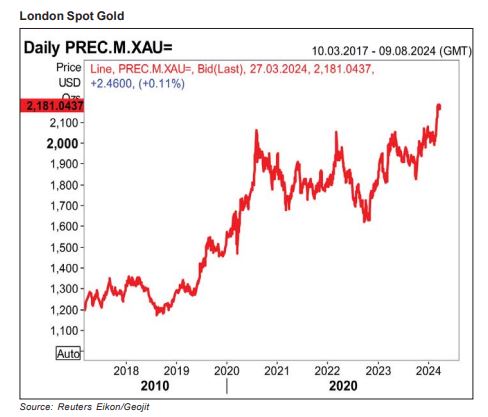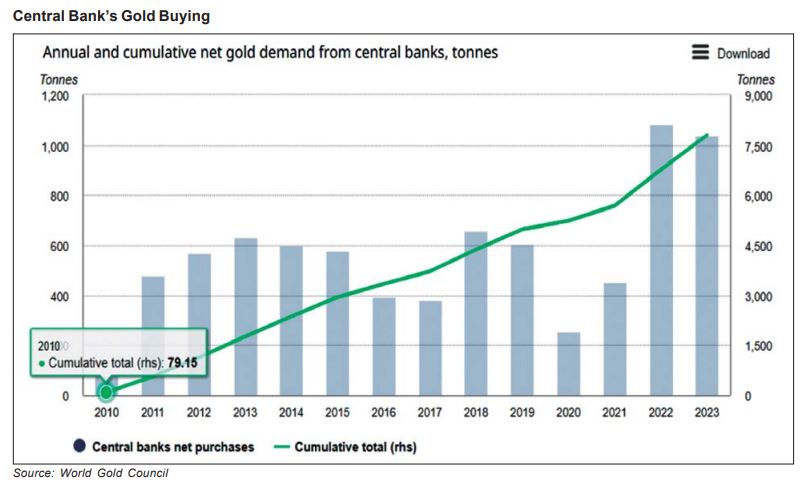Key takeaways
- Gold hits fresh record high in the third week of March
- High so far: London spot $2222 an ounce, MCX futures: Rs 66750 per ten grams
- Domestic gold gained more than 20 percent in the last 12 months
- Rising hopes of interest rate cuts aided gold’s rise
- Escalating geopolitical tensions and increased central bank buying provided additional support
- Investors cautiously waiting for US Fed policy decisions
Gold prices at historic highs

Gold prices recently touched historic highs both in the international and domestic markets. The benchmark London Spot gold hit a lifetime high of $2222 an ounce in the third week of March, surging more than 7 percent so far this year.
Taking cues from the overseas market, domestic gold also posted new lifetime highs. The most active MCX gold futures surged to a peak of Rs 66,750 per ten grams, gaining about 20 percent in the last twelve-month period.
Rising hopes for US interest rate cuts have aided the prices. In addition, the weak global economic outlook, escalating geopolitical tensions, US presidential election uncertainty, and higher central bank purchases have offered support to the yellow metal.
US Federal Reserve rate policy and the performance of the US dollar

The recent economic releases from the US and comments from the Federal Reserve officials have buoyed investors’ hopes that the central bank will likely cut its key interest rates in June, boosting the appeal of gold. However, the central bank is waiting for more data to confirm whether inflation is heading convincingly toward its target of 2 percent.
Hopes of US Fed’s rate cuts are significantly impacting the performance of bullion. Since there is no direct relationship between US interest rates and the price of gold, changes in interest rates largely affect the value of the US dollar which is inversely correlated to gold.
A cut in interest rates will lead to a lower yield for dollar-denominated assets which can in turn lead to a decline in the value of the US dollar. Since gold is priced in US currency globally, a weaker dollar makes gold cheaper for investors holding other currencies, which can increase the demand for gold and thus its price.
Also, gold does not pay interest or dividends. When interest rates are higher, the opportunity cost of holding gold is also higher. As interest rates fall, the opportunity cost of holding gold decreases, making it relatively more attractive compared to interest-bearing assets and potentially boosting demand for gold.
Weak global economic projections boosted the appeal of safe assets
The projection of a weak global economy amid a worsening geopolitical crisis is another key factor behind the sharp spike in prices. While the US has projected positive economic growth this year, there are estimations of a decline in other developed economies like Germany, Japan, and the UK. Economic de-growth typically increases the demand for gold as it is considered a hedge against inflation.
As per the World Bank forecasts, the global economy is set for the weakest half-decade performance in 30 years. They also hinted that the global trade growth in 2024 is expected to be only half the average in the decade before the pandemic.

Safe haven demand due to increased geopolitical instability
Investors consider gold as a safeguard against ongoing geopolitical instability. Issues such as the war between Israel and Hamas and prolonged Russia – Ukraine conflicts, US-China conflicts, the Gaza war, and the Presidential election in the US in November are looming on the minds of investors.
Geopolitical tensions often have a significant impact on the performance of gold. The yellow metal is considered a safe investment, meaning that investors tend to flock to it in times of uncertainty, instability, and geopolitical crisis.
When geopolitical tensions rise, investors become more risk averse. They fear that conflicts could negatively impact financial markets and economies across the globe. As a result, they seek refuge in assets like gold, which are historically perceived as safe investments.
Conflicts or wars between countries can lead to currency devaluation or depreciation. Investors may turn to gold as a hedge against these currency fluctuations, as gold is not tied to any specific currency and retains its intrinsic value.
In addition, gold is a highly liquid asset, which means it can be easily bought and sold, even in times of crisis. This liquidity makes it an attractive option for investors looking to move their funds quickly to volatile markets.
High central bank buying
Central banks are the key demand driver of gold in recent times. As per World Gold Council data, central banks have been buying gold at a record pace since 2010. In the last two successive years, central banks have acquired over 1000 tonnes and in 2024 the trend is expected to be intact. A vast majority of these purchases came from the central banks of emerging markets and many of them have been regular buyers over the past few years.


Fundamentals remain healthy for further rise
Looking ahead, though there are chances for an imminent correction, the broad bullish outlook remains intact due to healthy fundaments. Weakness in the US dollar, hopes of interest rate cuts, escalating geopolitical tensions, worries over the global economic outlook, and high central bank purchases would be the positive triggers for the commodity. Meanwhile, firm global equities and any changes in the Fed’s policy decisions would cause a downturn in prices later.
On the domestic side, since gold prices are at record highs, there are chances of a correction possibly in the first half of 2024. Meanwhile, a weak INR and expectations of jewellery demand would offer downside support and hence it may preserve its bullish outlook for the rest of the year.
Safe long-term bet for investors
Gold is one of the best long-term assets which offers both safety and decent return to its investors. Domestic gold has doubled in the last 5 years, and it surged more than 980 percent since 2003. Hence, investors can make use of every price correction to add the metal into his/her portfolio for long-term benefits.






